AS U.S. SANCTIONS strangle Iran’s economy, anti-government protests are spreading. This week on Intercepted: Iranian-American author and analyst Hooman Majd discusses a century of history marked by intervention and threats from major world powers. Beginning with Britain, Russia, and Germany battling for control of Iran’s oil, Majd and Jeremy Scahill discuss the CIA coup against Mohammed Mossadegh in 1953, the Islamic revolution, and the seizure of the U.S. embassy in Tehran in 1979 and how Washington has repeatedly tried to bring down the government of the Islamic Republic. The Intercept’s investigative series The Iran Cables offers historical insight into Iran’s operations in neighboring Iraq, which are informed by the bloody history of the Iran-Iraq War, the U.S. invasion, subsequent occupation, and the shattering of Iraqi society.
[…]
JS: We’re talking about what is driving the protests on just sort of a human level but who is organizing these protests? What do we know about the kind of opposition to the established government in Tehran right now? Is there a nexus of groups? Are there individuals or is this spontaneous?
HM: In this particular case, it’s mostly spontaneous, although exile groups have taken some credit and have sort of become the focal point of conversation about these protests.
JS: What kinds of exile groups?
HM: The monarchists and the MEK. The monarchists are claiming that people are shouting for Reza Pahlavi, the Shah’s son to come back. MEK are claiming that they have thousands and hundreds of thousands of supporters in Iran who are out on the streets. Not that they don’t have any supporters, I mean, that would be ridiculous. Of course, they have some support in Iran. And they have contacts and probably spies even inside the government. But to say that either one of these groups was able to instigate protests and riots and all kinds of vandalism in Iran in over 100 cities in the space of, you know, a day would mean that they’re much, much more powerful than we would think, and therefore, why haven’t they been able to overthrow the regime by now?
JS: Your analysis that you’re offering here is reminiscent of some of the conversation that we heard around Iraq in the 1990s where you had these totally discredited exile figures like Ahmed Chalabi getting a disproportionate amount of influence in Washington. You know, Iraqis I knew at the time used to say Ahmed Chalabi has much more of a constituency along the Potomac than he has along the Tigris, or Euphrates. And part of the plan early on in the invasion of Iraq and the toppling of Saddam that was a pretty popular concept in the CIA and elsewhere was to put Ahmed Chalabi in charge of the Iraqi government. This guy who was totally unknown to most Iraqis.
You’re talking about the MEK right now, which for a long time was a State Department designated terror organization and has had bipartisan political support in the United States from the likes of Howard Dean, Rudy Giuliani, John Bolton, Mike Pompeo, and others—
HM: Governor Richardson.
JS: Governor Richardson, right. I mean, but again, the United States government determined that this was a terror organization, you know, at one point and there was a huge lobbying campaign to lift it. Does it seem to you like the Trump administration policy seems to be a desire to place MEK people in charge of a new Iran? I mean, that was John Bolton’s position.
HM: I think that was John Bolton’s position, yes, but he’s gone. I also don’t—I find it very hard to believe that with all the—I mean, of course, with the Trump administration it’s hard to say. But with all the intelligence officers, all the analysts, all the think tanks that say that that’s not going to happen, that they will never be in charge of Iran, that we would think that that would still be OK. I mean—
JS: The Iranians of all political strifes would resist that.
HM: Including the monarchists who hate them, as well. And the monarchists do have a, you know, kind of presence in Washington as well. I mean, they may have been a useful tool for the United States and even in the delisting as a terrorist organization has been a useful tool in the toolbox that we have against regimes we don’t like. Let’s also remember the Iraqi people at the time that Chalabi was being groomed in Washington, were not, I mean, they didn’t have access to the internet. They weren’t very aware of what’s going on in the rest of the world. As you say, they hardly even knew who Chalabi was.
Iranians inside Iran, until Sunday night, were very connected. They have 4G on their phones. I mean, yes, a lot of sites are blocked in Iran but they could read the New York Times; they could be on Instagram, which are not blocked. They could get VPNs, and you know, they’re on Twitter and everything else. They’re much more aware of the MEK than for example, Iraqis would have been of Chalabi. And I don’t think we, when I say we, the United States had very much intelligence inside Iraq prior to the invasion of Iraq. Whereas we do have a lot of intelligence inside Iran, mainly because there’s two million Iranians living in America who go back and forth all the time.
JS: I think it would be really helpful to take a walk through some of the multi-decade history of how Iran ended up the way it is now, the way its government functions and the way that Iran has acted in Iraq, as evidenced by these cables. Let’s begin sort of in the 1930s or 40s. What was Iran like during that period? How was it governed? What was its standing in the world?
[…]
Jeremy Scahill, The Intercept

